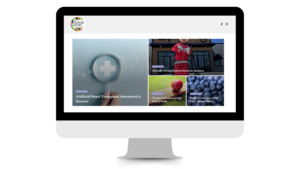I don’t know about you, but I sometimes feel that instead of consuming news, the news is consuming me. Between global conflict, elections across the world, political changes, natural disasters, local crime, wars, immigration, and deportation, talks of recession and more being reported every hour, it can feel overwhelming. It’s easy to go down a rabbit hole of reading article after article, despite the building stress each opened tab creates. This isn’t a singular event, nor is it unique to me. News is no longer bound by the daily paper or the 5 p.m. broadcast. It is everywhere, takes many forms, and can be disseminated immediately.
It can be tempting to want to tune out and stop reading the news altogether, and I’d be lying if I said I’d never considered it (and I work in the business of news!). But Senator Elissa Slotkin said something in a recent speech that really resonated with me: “Don’t tune out. It’s easy to be exhausted, but America needs you now more than ever.”
She’s right. Tuning out isn’t the answer and staying informed is a civic responsibility. The challenge is figuring out your news consumption without letting it burn you out. While there isn’t a one-size-fits all solution, here are a few strategies to help this balance.
Consume Media Mindfully
As I mentioned earlier, I understand both sides of the media consumption spectrum: doomscrolling and unplugging. Endlessly refreshing news or social media sites that are rife with constant updates and potential misinformation can cause feelings of distress or even loss of sleep. On the flip side, disengaging completely can lead to apathy, and uninformed people can make uninformed decisions, which creates more harm than good.
Instead of quitting the news entirely, try mindful news consumption:
- Choose quality over quantity: follow reputable sources that prioritize factual reporting over sensationalism, and avoid clickbait-driven, provoking headlines.
- Limit social media news consumption: while platforms like X and Instagram can provide real-time updates, they often mix misinformation and extreme opinions with legitimate news.
- Balance hard news with positive stories: there’s still good news out there! Follow a few accounts like the Good News Movement or Some Good News to get exposure to a mix of feel-good stories.

By engaging with the news intentionally, you can stay informed without feeling emotionally drained.
Find Reliable News Roundups
One of the best ways to stay updated without getting sucked into an endless news vortex is to listen to daily news round-up podcasts. These programs condense the biggest stories of the day into 15–30-minute episodes, giving you a comprehensive briefing without requiring hours of reading. Here are a few recommendations from me and my colleagues:
- NPR’s Up First: a 10-minute podcast featuring the three biggest stories of the day
- The New York Times’ The Daily: a 25-ish-minute podcast that dives into the top one or two stories of the day
- ABC News’ Start Here: a 20-30-minute podcast that gives a straightforward look at the days top news.
Alternatively, newsletters are a great way to learn more about the main stories of the day, as they often summarize the article, but still link to it so you can read the whole story if you choose. There are so many different types: general news of the day roundups, vertical-specific newsletters, national and local newsletters, daily and weekly newsletters, and many more. With Substack also taking off, many news influencers can also now have a newsletter platform. Here are a few that I make time to read:
- The Skimm: a curated selection of the day’s key stories with a focus on empowering women.
- WBUR Today: Boston’s morning newsletter that I use to keep up with local news and its relation to what’s going on nationally.
- New York Times The Morning: essentially its podcast counterpart, this is another resource from the Times that I like to go through to get an overview of what’s going on that day.
Starting my day by either listening to a podcast, reading newsletters, or both if I have the time has helped me know what is going on without feeling inundated.
Set Boundaries
Constant exposure to breaking news updates can create a sense of urgency and stress that isn’t sustainable. Instead of checking the news at all hours of the day, schedule when and how you engage with the news – and stick to it. A couple of strategies include:
- Pick a designated news time: this could be during your morning coffee, at lunch, or an evening recap.
- Turn off push notifications: most news notifications don’t need to interrupt your day. If it’s truly urgent, you will hear about it in multiple different ways anyway.
- Set a time limit: give yourself a set amount of time for news consumption – 30 minutes in the morning, watching the nightly news, etc. – and then pivot to a different activity. I personally like to do something analog, like reading a book or painting, so I’m not tempted to doomscroll more.
There’s a lot happening in the world that demands our attention. But staying informed doesn’t have to mean sacrificing well-being. Mindful news consumption, using roundups for efficiency, and setting boundaries on when and how you engage, can help you strike a balance between being an informed citizen and protecting your mental health. Besides, you’ll never know what good news you’ll see sprinkled in every now and then too!


